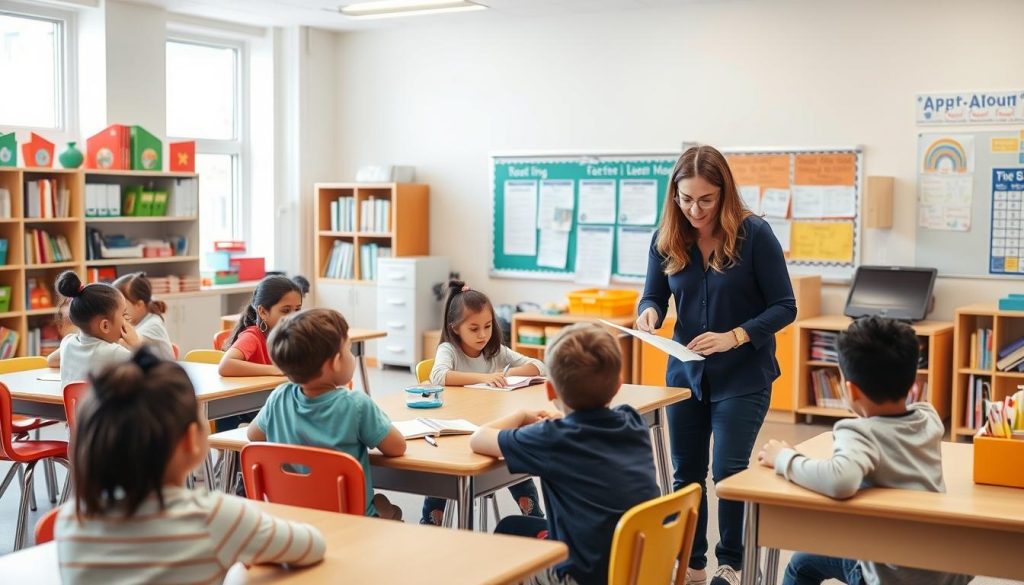In this comprehensive guide, we’ll explore eight proven differentiation strategies that you can implement immediately in your K-12 classroom. Each approach is designed to help you create a more inclusive, engaging, and effective learning environment where all students can thrive. Let’s dive in and discover how these powerful techniques can transform your teaching practice.
Differentiation Strategy #1: Tiered Assignments for Mixed-Ability Classrooms
One of the most effective differentiation strategies is the use of tiered assignments. This approach allows you to teach the same concept to all students while adjusting the complexity, depth, or abstractness based on student readiness. Think of it as creating multiple entry points to the same destination.

How to Implement Tiered Assignments
Start by identifying the core concept or skill you want all students to master. Then, create multiple versions of the assignment that vary in:
- Complexity of the task
- Number of steps required
- Amount of structure provided
- Level of abstract thinking needed
- Depth of knowledge required
For example, in a math class studying fractions, you might create three tiers:
Tier 1
Basic fraction identification and simple addition with visual supports and step-by-step guidance.
Tier 2
Mixed fraction operations with some visual supports and guided practice.
Tier 3
Complex fraction problem-solving in real-world contexts with minimal scaffolding.
The beauty of tiered assignments is that all students work toward the same learning goals but through appropriately challenging pathways. This strategy respects students’ current abilities while pushing them to grow.
Learn more about implementing tiered assignments effectively here.
Ready to transform your differentiation practice?
Discover our comprehensive differentiation toolkit with ready-to-use templates for tiered assignments and more.
Differentiation Strategy #2: Project-Based Learning with Multiple Pathways
Project-based learning (PBL) naturally lends itself to differentiation because it allows students to explore concepts through various approaches and demonstrate learning in different ways. When thoughtfully designed, PBL can address diverse learning needs while maintaining high expectations for all students.
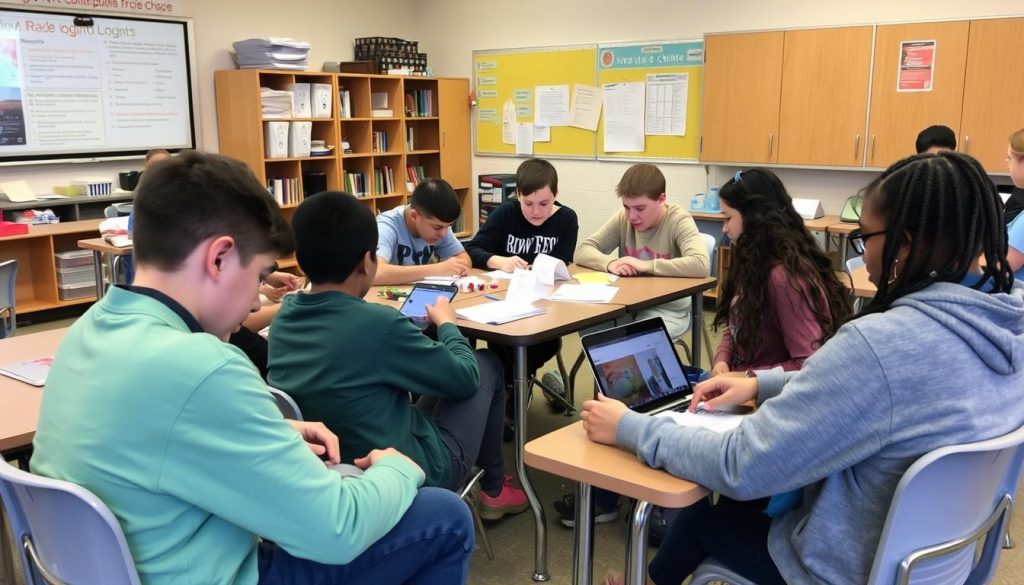
Five Key Differentiation Strategies for Project-Based Learning
- Flexible Grouping: Strategically group students based on readiness, interests, or learning profiles to maximize learning opportunities.
- Choice Boards: Provide options for how students can explore the topic, gather information, and demonstrate understanding.
- Scaffolded Research: Offer research materials at various reading levels and complexity to support different learners.
- Varied Product Options: Allow students to demonstrate learning through different formats (presentations, models, written reports, videos, etc.).
- Personalized Checkpoints: Create individualized check-in schedules and support based on student needs.
When implementing differentiated PBL, remember that the goal isn’t to create entirely different projects for each student, but rather to provide multiple pathways through the same project framework. This approach honors student differences while maintaining cohesion in your classroom.
Discover more differentiation strategies for project-based learning here.
“Effective differentiation in project-based learning isn’t about lowering expectations for some students—it’s about providing appropriate supports and challenges so all students can reach high standards through different paths.”
– Carol Ann Tomlinson
Offering Student Choice: A Powerful Differentiation Strategy
Student choice is one of the most accessible and effective differentiation strategies available to teachers. When students have meaningful choices in their learning, engagement increases, motivation improves, and students naturally gravitate toward options that match their learning preferences and readiness levels.
Ways to Incorporate Choice in Your Classroom
Content Choices
- Different texts on the same topic at various reading levels
- Multiple research questions within a broader theme
- Various media formats (articles, videos, podcasts)
- Different entry points to explore a concept
Process Choices
- Working alone, with a partner, or in a small group
- Using different tools or materials
- Following different sequences of activities
- Varying time allocations for different tasks
Product Choices
- Written reports, presentations, videos, or artistic creations
- Digital or physical formats
- Formal or informal demonstrations of learning
- Real-world applications or theoretical explorations
Environmental Choices
- Different seating options or work locations
- Music or quiet working conditions
- Lighting preferences
- Standing or sitting work stations
The key to effective choice is ensuring that all options lead to the same learning goals. Choice isn’t about letting students do whatever they want—it’s about providing meaningful options that respect their differences while maintaining academic rigor.
Learn more about enhancing differentiation through student choice here.
Teacher Tip: Start small with choice by offering just 2-3 options in one area of your instruction. As you and your students become more comfortable with choice, gradually expand the options and areas where choice is offered.
Differentiation Strategy #4: Learning Stations for Varied Instruction
Learning stations (also called centers or rotations) are physical areas of your classroom where students engage with content in different ways. This differentiation strategy allows you to provide varied approaches to learning while managing small group instruction effectively.
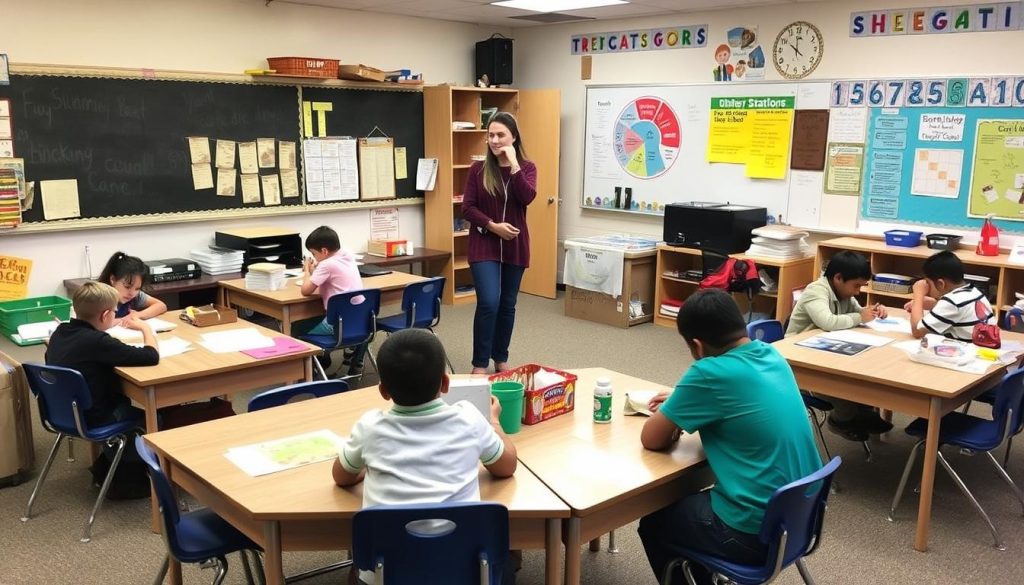
Benefits of Learning Stations for Differentiation
- Allows for simultaneous different activities addressing various learning needs
- Creates opportunities for targeted small-group instruction
- Accommodates different learning paces and styles
- Provides natural movement breaks for kinesthetic learners
- Enables practice of different skills within the same lesson framework
Types of Learning Stations for Effective Differentiation
Teacher-Led Station
Provides direct instruction, reteaching, or extension with teacher guidance. Perfect for addressing specific needs of small groups.
Independent Practice Station
Offers opportunities for students to apply skills independently at their own level. Can include tiered activities for different readiness levels.
Collaborative Station
Encourages peer learning and discussion. Students can work together on problems or projects that benefit from multiple perspectives.
Technology Station
Utilizes adaptive software or digital resources that automatically adjust to student performance levels.
Creation Station
Allows students to demonstrate understanding through hands-on projects, art, or multimedia creations.
Reflection Station
Provides prompts and tools for students to think about their learning process and set goals for improvement.
When implementing learning stations, start with just 2-3 stations and gradually expand as your management systems become more established. Clear directions, timing signals, and transition procedures are essential for success.
Discover more about enhancing differentiation with learning stations here.
Need help organizing effective learning stations?
Our differentiation professional development course strategies & management tools for any subject area.
Differentiation Strategy #5: Effective Small Group Instruction
Small group instruction is a cornerstone of effective differentiation strategies. By working with fewer students at once, you can target specific needs, provide appropriate challenges, and offer more personalized feedback. This approach allows you to meet students where they are while moving them forward at an appropriate pace.
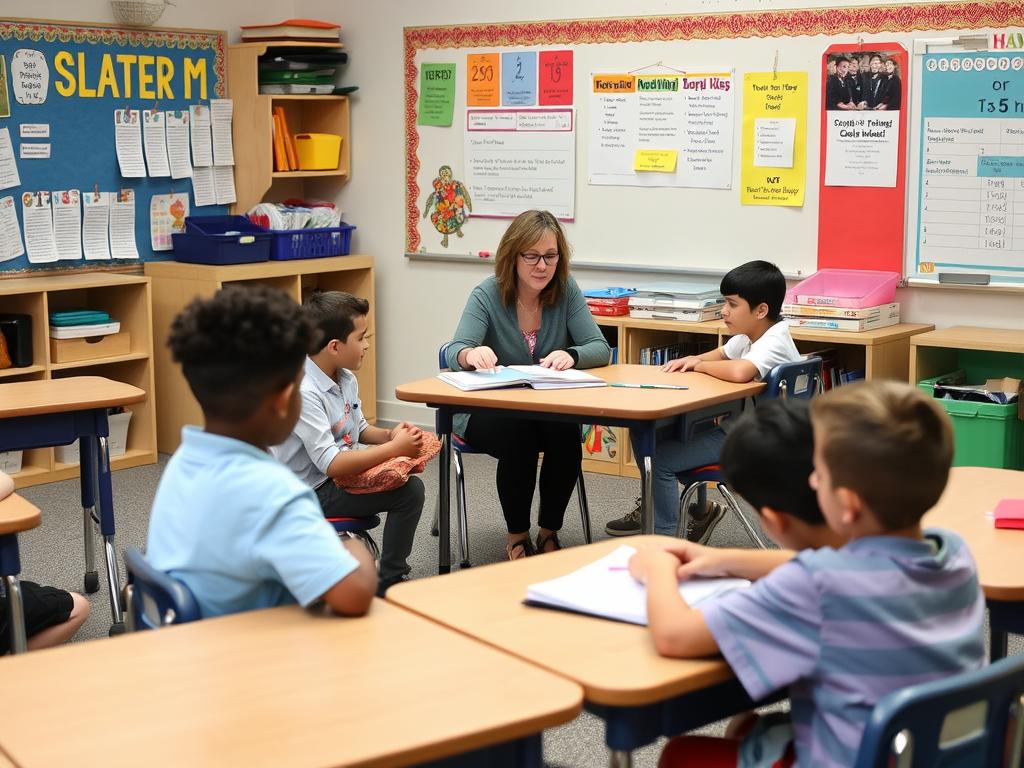
Eight Strategies to Improve Small Group Instruction
- Data-Driven Grouping: Form groups based on assessment data rather than arbitrary factors. Groups should be flexible and change as student needs evolve.
- Clear Learning Targets: Establish specific objectives for each small group session so students understand what they’re working toward.
- Targeted Materials: Select resources that address the specific needs of each group rather than using one-size-fits-all materials.
- Structured Routines: Establish consistent procedures for transitions, materials management, and behavior expectations during small group time.
- Meaningful Independent Work: Ensure that students not working with you are engaged in valuable, level-appropriate tasks that reinforce learning.
- Strategic Questioning: Use questions that probe student thinking and encourage deeper understanding rather than simple recall.
- Immediate Feedback: Provide in-the-moment guidance to correct misconceptions and reinforce successful strategies.
- Progress Monitoring: Track student growth within small groups to adjust instruction and determine when regrouping is needed.
Small group instruction works best when integrated with other differentiation strategies like learning stations, tiered assignments, and student choice. This comprehensive approach ensures that all students receive the support and challenge they need.
Learn more about improving small group instruction here.
Planning Tip: When scheduling small groups, aim to meet with struggling students more frequently (daily if possible) and advanced students 2-3 times per week. This allocation of time helps close gaps while still challenging high achievers.
Differentiation Strategies for Connecting with All Ability Levels
One of the greatest challenges teachers face is effectively reaching students across the full spectrum of abilities. From students who struggle significantly to those who are far ahead of grade-level expectations, differentiation strategies help you connect with everyone in meaningful ways.

Closing the Achievement Gap Through Differentiation
Effective differentiation isn’t just about helping struggling students catch up—it’s about ensuring that every student makes continuous progress from their starting point. This approach helps close achievement gaps while challenging advanced learners.
Strategies for Supporting Struggling Learners
- Break complex tasks into smaller, manageable steps
- Provide visual supports and concrete examples
- Offer sentence starters and writing frames
- Use graphic organizers to structure thinking
- Implement frequent check-ins and feedback
- Allow for extended processing time
Strategies for Challenging Advanced Learners
- Increase complexity and abstract thinking requirements
- Incorporate open-ended problem-solving
- Encourage deeper research on related topics
- Provide opportunities for real-world application
- Introduce advanced vocabulary and concepts
- Allow for creative extensions of core content
The key to connecting with all ability levels is maintaining high expectations while providing appropriate supports. Every student should be working in their “zone of proximal development”—challenged enough to grow but supported enough to succeed.
Discover more strategies for connecting with all ability levels here.
“Fair isn’t everybody getting the same thing. Fair is everybody getting what they need in order to be successful.”
– Rick Wormeli
By implementing these differentiation strategies consistently, you create a classroom where all students feel valued and capable of growth. This approach not only improves academic outcomes but also builds students’ confidence and love of learning.
Differentiation Strategy #7: Planning Tools for Diverse Learners
Effective differentiation begins with intentional planning. Having the right tools and frameworks helps you design lessons that proactively address the diverse needs in your classroom rather than making reactive adjustments on the fly.

Five Essential Planning Tools for Differentiation
Pre-Assessment Templates
Tools for gathering data about student readiness, interests, and learning preferences before instruction begins. These help you identify starting points and potential groupings.
Tiered Lesson Planners
Frameworks that help you design multiple pathways through the same content based on student readiness. These typically include core content and activities at different levels.
Learning Menus/Choice Boards
Templates for creating structured choice options that address different learning preferences while ensuring all students master essential content.
Flexible Grouping Charts
Tools for planning and tracking various student groupings based on data, ensuring that groups remain fluid and purposeful throughout a unit.
Formative Assessment Trackers
Systems for monitoring student progress during instruction to make real-time adjustments to differentiation approaches.
Reflection and Adjustment Protocols
Structured processes for evaluating the effectiveness of differentiation strategies and making improvements for future lessons.
These planning tools help you move from the theory of differentiation to practical implementation in your daily teaching. By building differentiation into your planning process, you create more cohesive and effective learning experiences for all students.
Explore these lesson planning tools for diverse learners in detail here.
Streamline your differentiation planning
Access our complete collection of differentiation strategies & tools to save time while meeting all student needs.
Remember that effective planning doesn’t mean creating entirely separate lessons for different students. Instead, it means thoughtfully designing flexible learning experiences that can be adjusted based on student needs while maintaining focus on essential learning goals.
For more ideas on creating an inclusive classroom environment that supports differentiation, visit Credits for Teachers for additional resources and strategies.
Differentiation Strategy #8: Scaffolding for Student Success
Scaffolding is a critical differentiation strategy that provides temporary supports to help students bridge the gap between what they can do independently and what they can achieve with assistance. Like scaffolding on a building, these supports are gradually removed as students develop competence.
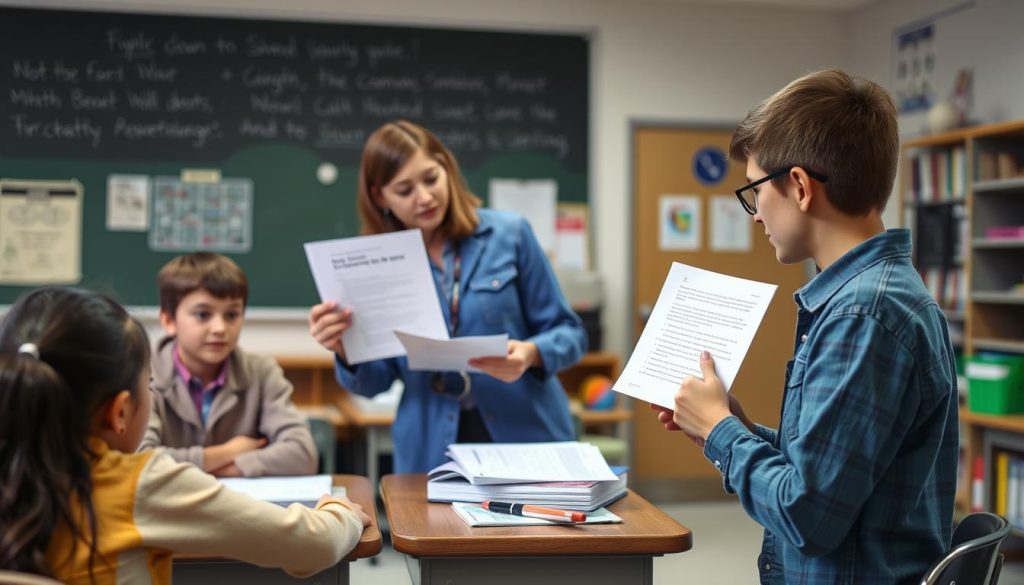
Five Powerful Scaffolding Strategies for K-12 Classrooms
- Modeling: Demonstrating processes and thinking strategies explicitly before asking students to perform independently. This includes think-alouds, worked examples, and demonstrations.
- Graphic Organizers: Providing visual frameworks that help students organize information and see relationships between concepts. These can be adjusted in complexity based on student needs.
- Sentence Frames/Starters: Offering partial language structures that support students in articulating complex ideas, particularly beneficial for English language learners and struggling writers.
- Chunking: Breaking complex tasks or information into smaller, manageable parts with clear checkpoints. This helps prevent cognitive overload and builds confidence.
- Gradual Release of Responsibility: Following the “I do, we do, you do” sequence that systematically transfers responsibility from teacher to student as competence develops.
Implementing Effective Scaffolding
The key to successful scaffolding is finding the right balance—providing enough support to enable success without creating dependency. This requires ongoing assessment and adjustment based on student progress.
Signs of Too Much Scaffolding
- Students wait for help before attempting work
- Lack of independent problem-solving
- Resistance when supports are removed
- Limited growth in skills over time
Signs of Too Little Scaffolding
- Frequent frustration or giving up
- Work completion without understanding
- Avoidance behaviors
- Minimal progress despite effort
Effective scaffolding is responsive to individual needs and gradually fades as students develop independence. This differentiation strategy empowers students to take ownership of their learning while ensuring they have the support needed for success.
Learn more about implementing scaffolding strategies in your classroom here.
Important Reminder: Scaffolding is meant to be temporary. Regularly assess whether students still need particular supports and gradually remove them as students demonstrate independence.
For more comprehensive resources on differentiation strategies, including scaffolding techniques for specific subject areas, visit Credits for Teachers.
Implementing Differentiation Strategies: Start Small and Build
While these eight differentiation strategies are powerful tools for meeting diverse student needs, trying to implement them all at once can be overwhelming. Instead, take a gradual approach that allows both you and your students to adjust to new ways of teaching and learning.
A Step-by-Step Approach to Differentiation
- Start with Pre-Assessment: Begin by gathering data about your students’ readiness, interests, and learning preferences. This information will guide your differentiation decisions.
- Choose One Strategy: Select a single differentiation strategy that aligns well with your teaching style and student needs. Master this approach before adding others.
- Plan Thoroughly: Invest time in detailed planning for your chosen strategy. Clear procedures and expectations are essential for success.
- Communicate with Students: Explain to students why you’re using differentiation and how it will help them learn. Transparency builds buy-in.
- Start Small: Implement your chosen strategy in one subject area or for a single unit before expanding.
- Reflect and Adjust: Regularly evaluate what’s working and what needs improvement. Be willing to make changes based on student responses.
- Gradually Add More: As you and your students become comfortable with one approach, slowly incorporate additional differentiation strategies.
Remember that effective differentiation is a journey, not a destination. Even experienced teachers continually refine their approach based on student needs and new insights about learning.
“The goal of differentiation is maximum growth for each student—from whatever their starting point might be.”
– Carol Ann Tomlinson
By thoughtfully implementing these differentiation strategies, you create a classroom where all students can experience success and develop a love of learning. Your efforts to meet diverse needs don’t just improve academic outcomes—they show students that you value them as individuals and believe in their potential.
For additional support with implementing differentiation strategies in your classroom, explore the comprehensive resources available at Credits for Teachers Differentiation Resources.
Additional Resources for Differentiation Strategies
To deepen your understanding and implementation of differentiation strategies, explore these valuable external resources:
ASCD Resources on Differentiation
The Association for Supervision and Curriculum Development offers extensive articles, videos, and webinars on differentiation from leading experts including Carol Ann Tomlinson.
Edutopia’s Differentiated Instruction Guide
Edutopia provides research-backed articles, videos, and case studies showing differentiation strategies in action across various grade levels and subject areas.
These resources complement the strategies we’ve explored and provide additional perspectives on effective differentiation in today’s diverse classrooms.
Bringing Differentiation Strategies to Life in Your Classroom
Implementing effective differentiation strategies isn’t about creating more work for yourself—it’s about working smarter to meet the diverse needs in your classroom. By thoughtfully incorporating these eight approaches into your teaching practice, you create an environment where all students can thrive.
Remember that differentiation is not about creating a different lesson for each student, but rather about providing multiple pathways to the same learning goals. By focusing on student readiness, interests, and learning preferences, you can create a classroom that honors diversity while maintaining high expectations for all.
As you continue your differentiation journey, keep experimenting, reflecting, and refining your approach. The strategies we’ve explored—tiered assignments, project-based learning, student choice, learning stations, small group instruction, connecting with all ability levels, planning tools, and scaffolding—provide a comprehensive toolkit for meeting diverse student needs.
Ready to transform your differentiation practice?
Access our complete differentiation graduate-level (500+) course with ready-to-use tools & implementation strategies for your classroom.
Your commitment to differentiation makes a profound difference in your students’ educational experience. By meeting them where they are and providing appropriate challenges, you help each student develop not just academic skills but also confidence, independence, and a love of learning that will serve them throughout their lives.

